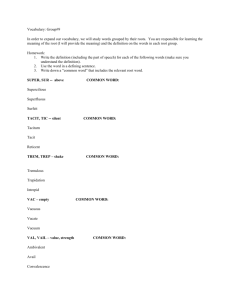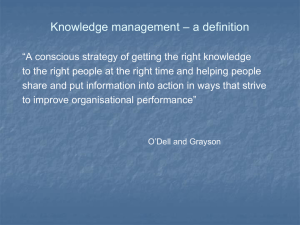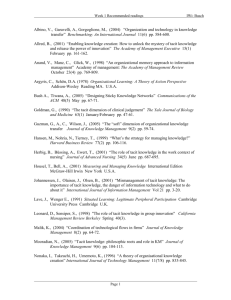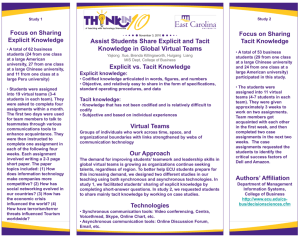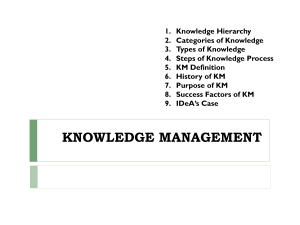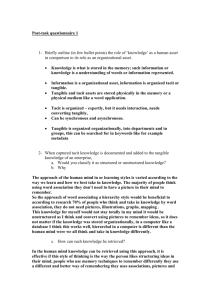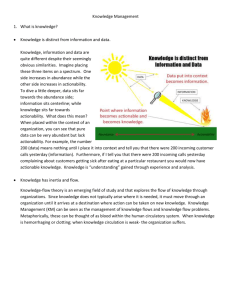knowware Gilson Schwartz Visiting Professor, Information and Communication
advertisement
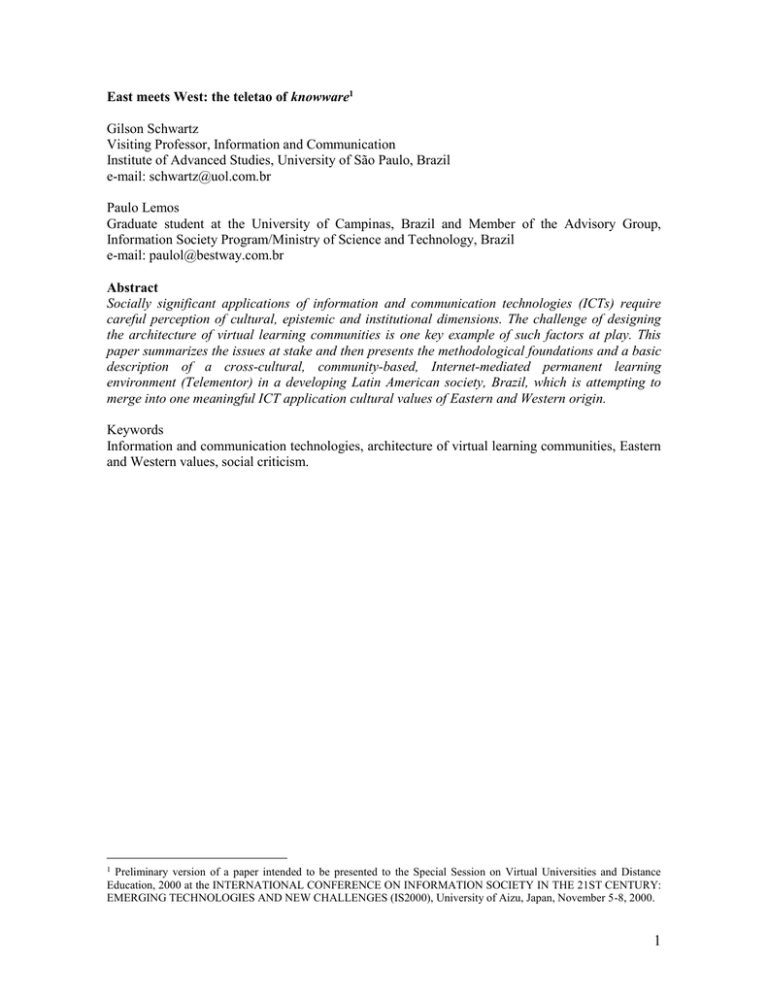
East meets West: the teletao of knowware1 Gilson Schwartz Visiting Professor, Information and Communication Institute of Advanced Studies, University of São Paulo, Brazil e-mail: schwartz@uol.com.br Paulo Lemos Graduate student at the University of Campinas, Brazil and Member of the Advisory Group, Information Society Program/Ministry of Science and Technology, Brazil e-mail: paulol@bestway.com.br Abstract Socially significant applications of information and communication technologies (ICTs) require careful perception of cultural, epistemic and institutional dimensions. The challenge of designing the architecture of virtual learning communities is one key example of such factors at play. This paper summarizes the issues at stake and then presents the methodological foundations and a basic description of a cross-cultural, community-based, Internet-mediated permanent learning environment (Telementor) in a developing Latin American society, Brazil, which is attempting to merge into one meaningful ICT application cultural values of Eastern and Western origin. Keywords Information and communication technologies, architecture of virtual learning communities, Eastern and Western values, social criticism. 1 Preliminary version of a paper intended to be presented to the Special Session on Virtual Universities and Distance Education, 2000 at the INTERNATIONAL CONFERENCE ON INFORMATION SOCIETY IN THE 21ST CENTURY: EMERGING TECHNOLOGIES AND NEW CHALLENGES (IS2000), University of Aizu, Japan, November 5-8, 2000. 1 1. Midiatic capitalism, knowledge economy and peripheric development Midiatic capitalism is a new regime of capital accumulation regulated by the value aggregation of knowledge creating activities and the development of intangible assets (brands, consumer habits, technological standards and service-based value chains). The term “midiatic” stresses not only the growing role of midia (ICTs or information and communication technologies) but also the key function of intermediaries in the organization of productive and distributional networks. Infomediaries, regulators and knowledge-based business consortia are examples of economic actors defined by their position as intermediaries in value chains, power dynamics and organizational structures. This perspective requires new approaches to governance in the context of rapid globalization. For the peripheric nation-states of the world system, a new threat emerges: there is a growing concern not only with technological and knowledge gaps, but also with the emergence of a digital divide within developing societies. On the other hand, neo-illuminists preach on the creation of new development opportunities based on new technologies. One important consequence of this techno-based optimism has been the emerging markets mania which finally led to the so-called Asian crisis of 1997, as a matter of fact a global crisis that severely affected most of the developing world. Before the crisis, several countries became known as “big emerging markets” as a result of their economic success: South Korea, Brazil, China, India, Mexico and South Africa are some of the most often mentioned. They seem to achieve, despite recurrent crises and institutional instability, new levels of regional and global power. But for many segments of the population in these societies the opportunities of globalization have also created higher unemployment, dislocation, and financial uncertainty. It should be stressed that these countries have made great strides in developing indigenous information technology industries. India is certainly the most cited case, but South Korea and Brazil also developed peculiar paradigms in the ICT field. In more than one respect, these developing nations are also entering a stage of midiatic capitalism centered on the expansion of the knowledge economy. Notwithstanding, from political, epistemological and institutional perspectives these late capitalisms are only beginning to build up confidence and organizational cultures akin to the new development paradigms based on ICTs. The purpose of this paper is to advance suggestions with respect to the cultural and institutional building efforts needed in order to bridge the development gaps of the socalled big emerging markets. 2 2. Network architectures: community values and learning experiences In India, the university system produces 240,000 engineers a year, but only 40% of Indian women and a quarter of the men can read, while 35% of the country's population lives below the poverty line. Only 19 of every thousand people have access to telephone main lines, and 2 of every thousand have personal computers. The cost of Internet access is approximately $42 for 20 hours/month, or 8% of per capita GDP. In Brazil, the typical access cost would be lower, about $15 for 20 hours/month, but this amounts to about 12% of the national minimum wage set by the federal government. However, Indian engineers thrive in the Silicon Valley and Bangalore has become a landmark in the globalization of the software industry. Brazil is Latin America's Internet powerhouse. With half the region's population, it is the single largest market for Internet services and e-commerce. Because 49% of Brazilians are 24 and under, in the next decade this "baby boom" will form a potentially lucrative internet market. The number of Brazilian adults (over 18) who use the internet more than one hour per week is expected to grow from 4.25 million in 2000 to 10.34 million by 2003. As a percentage of the wealthiest 15% of the population, the penetration rate is 25.27% in 2000 and expected to more than double to 58.11% in 2003. The main question in face of these inequalities is: “whose Internet is to be developed?”. Are we condemned to wait for a natural expansion of the market or can we alter this profile through policyled changes in the organizational cultures of companies and communities? The Internet and the digital economy look quintessentially American. The core technology was developed and has diffused most rapidly in the U.S. The lead firms in e-commerce are American. The lead governance functions, such as the granting of domain names, are American or dominated by American interests. While on the other hand, the Internet is by its very structure culturally pluralistic and, in its structural openness, it represents the ultimate vehicle for global economic liberalization, integration, and dynamism. For these very reasons, the rise of the Internet and the digital economy threaten entrenched interests and arouse fears of loss of control over collective life and cultural identity. In order to face these challenges, the role of networks must be stressed and their communitarian, public nature should be ranked first among the organizational features of the emerging development paradigm. However, this is clearly contrary to the ideology of the U.S.-led, privatist and corporation dominated development model (although the American scene also stages opposing, communitybased and libertarian attitudes as well as views of communities as the most adequate economic space for marketing and economic development2. New regulatory controls and grassroots development of networks could work as antidotes for the ultraliberal approach to midiatic capitalism. One should look for alternative governance strategies at various levels (family, companies, governments and international public spaces). The perception of this new agenda is gaining momentum – and the so-called Asian crisis certainly contributed to a positive, pro-active revision of the totally free markets approach. Notions of shared See, for instance, John Hagel III and Arthur G. Armstrong, Net Gain – Expanding Markets through Virtual Communities, Harvard Business School Press, 1997. 2 3 knowledge, shared global priorities and an updated reflection on the theory of public goods come to the fore.3 The revolutionary implications of the Internet and the digital economy now require the State and non-governmental organizations from civil society (NGOs) to take on new roles and develop new policies and governance institutions. The increasingly global character of the digital economy has prompted the advocacy of international governance bodies, the incorporation of foreign interests in American dominated institutions, and the development of new organizational forms for governance of the digital economy such as privatized or quasi-private governance institutions (even companies beginning to favor self-regulated agencies to tame market forces or build up compensatory policies). Alternative views of the new society could emerge out of the “new economy” (or even new business models and organizational cultures as symptoms of a new economy), as opposed to the ultraliberal, U.S.-led view can be built on the spread of leading-edge users of the Internet and ecommerce in other parts of the world (Europe, Asia and Latin America). Of course, innovative and critical intellectuals in the U.S. are also embracing this approach.4 As new e-commerce technologies, uses, business models, and legal frameworks develop outside the U.S., they challenge the early dominance of American policy and market leadership. In this view, the outcome of these divergent or conflicting technological, economic, and regulatory developments may be a number of differing knowledge economies reflecting specific local, national and regional communities. These communities may drive distinctive lines of technology development in which local firms may have an advantage. Differences in policy will affect the development of technology, markets and products. These challenges are already very clear in U.S. – European Union (EU) negotiations. Even senior U.S. officials involved in the dispute with the EU over privacy protection in electronic commerce recognize that “harmonization of policy is unlikely and undesirable”.5 "I think it is unlikely because of differences in traditions, history and personal preferences that we will have the same set of rules everywhere. That's probably good", said the Special Advisor to the U.S. Secretary of Commerce for the Digital Economy. What this had led to is a recognition of a very large space of shared beliefs between the United States and the EU about the “need to protect”. But the European Commission cautions that European lawyers and pressure groups could soon start agitating for stopping data flows across the Atlantic. Moreover, "there are distinct patterns of development that are rooted in different ways of organizing markets for networks and commerce. There are different conceptions of what should be intellectual property and the way privacy should be arranged," said John Zysman, of the University of California, Berkeley. He also advocates a reconciliation of American, European and Asian positions on how to structure the digital economy as a new market place. There will not be one Internet-based market place but many, conditioned by policy choices. See especially Global Public Goods – International Cooperation in the 21st Century, Inge, K. (ed.), Oxford University Press, Oxford, 1999. An original understanding by an economist of knowledge as a public good was presented by Keneth Arrow in 1962 in “The Implications of Learning by Doing”, Review of Economic Studies 29:155-73. 4 Especially Eli Noam, “Internet-TV: the next generation of media”, presented to the XIII Biennial Conference of the International Telecommucations Society (ITS), Buenos Aires, July, 2-5, 2000, who advocates new forms of nanoregulation and cultural determination of ICTs. 5 “Diversity Emerges In Electronic Market Place”, 5/12/99, by Phillip Kurata USIA Staff Writer (http://economy.berkeley.edu/press/pressrel/060499.html). 3 4 A pressing research topic, then, is related to the identification and development of alternative regulatory environments and policies. Examples abound. For instance, policies regarding universal access, expanding the scope from the traditional vision of universal access to telephony into a vision of access to networks and services like Internet and e-gov. Other examples include competition policies, diffusion of network technologies and design of network architecture, again expanding the scope of this concept which has been mainly associated to the physical infrastructure of networks. This constitutes an intellectual territory that must express highly diversified and transdiciplinary approaches. We believe that community values and collective learning experiences should form the axis for the development of new paradigms in this expanded field of network architecture. The cultural and educational implications of such a broader view of network design are vast. Two complementary ideas should be taken into account: the idea of design and the idea of plastic, evolutionary networks. In both, interaction is the key to change and innovation. Experienced designers already realize the new trend to treat design as a cultural rather than strictly technical or functional competence. One such case is exemplified by the father of modern Japanese design, Takuo Hirano, for whom “until the present, designers have been closer to manufacturers than to consumers. Designers must alter this relationship by becoming (…) less dependent on the leadership and demands of manufacturers (…) designers must develop interactive relationships with both users and producers”(italics added).6 With respect to a plastic and evolutionary view of network architecture, leading researchers also are coming to realize that no fixed boundaries should be placed between the physical infrastructure and the social, cultural and institutional context of interaction. For Phil Agre, for instance, “confusion about technology arises partly because the word "technology" shifts silently among different uses. Its narrowest use pertains to physical artifacts such as laptop computers. But artifacts do not simply drop from the sky. They come surrounded by cultural meanings (liberatory or oppressive, rational or spiritual, stabilizing or disruptive, traditional or modern, elitist or populist, and the like), and they are knitted into institutional arrangements (access, identity, maintenance, budgeting, space allocation, compatibility, intellectual property, and so on). If we focus only on the artifact, then the cultural meanings and institutional arrangements become invisible. In fact, the relationship between artifacts, meanings, and institutions is complicated and variable.” Moreover, and again quoting at length, “information technology is enormously plastic. Computers can be designed in a boundless variety of ways. You construct a computer by picking a metaphor, any metaphor, and translating it into the logic of software or hardware. We can be certain that information technology will continue to improve in quantitative terms: its processor speed, memory capacity, screen resolution, communications bandwidth, and so on. But the qualitative, architectural aspects of information technology are not at all inevitable. The clean, layered design of the Internet, for example, arose partly because it was funded by an organization, the US military, that did not need to profit by controlling what applications would be run on it. Those factors result from negotiations among the producers and users of the technology. And this is where technology can become ideological: if you believe that information technology as such inevitably brings markets, or hierarchies, or freedom, or modularity, or conflict, or God-like control over human affairs, then you may not even recognize that you have choices”.7 Takuo Hirano, “The Development of Modern Japanese Design: A Personal Account”, in Victor Margolin and Richard Buchanan, The Idea of Design, The MIT Press, 1998. 7 Phil Agre, “The Distances of Education”, in Academe, Sept.-Oct., 1999, Volume 85, Number 5 on “Education Bytes: The Problems and Promise of Technology”. 6 5 3. Community values and the construction of public spaces It should be stressed that the US has been one of the leading territories for the expansion of community-based construction of collective organizations known as “non-profit organizations”. In 1999 alone, Mr. Bill Gates and his wife have poured $16-billion into the Bill & Melinda Gates Foundation. Corporate contributions jumped by 12 percent last year. Donations to charity in the US reached $190 billion in 1999. To cite at length one of the leading organizations in the development of this community-based development of social life, Peter F. Drucker, Clarke Professor of Social Sciences at the Claremont Graduate University in Claremont, California: “Society in all developed countries has become pluralist and is becoming more pluralist day by day. It is splintering into a myriad of institutions each more or less autonomous, each requiring its own leadership and management, each having its own specific task. This is not the first pluralist society in history. But all earlier pluralist societies destroyed themselves because no one took care of the common good. They abounded in communities but could not sustain community, let alone create it. If our modern pluralist society is to escape the same fate, the leaders of all institutions will have to learn to be leaders beyond the walls. They will have to learn that it is not enough for them to lead their own institutions -- though that is the first requirement. They will also have to learn to become leaders in the community. In fact they will have to learn to create community. This is going way beyond what we have been discussing as social responsibility. Social responsibility is usually defined as doing no harm to others in the pursuit of one's own interest or of one's own task. The new pluralism requires what might be called civic responsibility: giving to the community in the pursuit of one's own interest or of one's own task. There is no precedent in history for such civic responsibility among institutional leaders.” According to Drucker, the last pluralist society in the West existed during the early and high Middle Ages.8 The Roman Empire tried, quite successfully, to create a unitary state in which Roman law “The New Pluralism”, chapter 1 of Peter F. Drucker, Leading Beyond the Walls, Iain Somerville et alii (Editor), Drucker Foundation, 1999. 8 6 and the Roman legions created political uniformity throughout the empire while cultural diversity was preserved. But after the collapse of the Roman Empire, this unity splintered completely. In its stead arose a congeries of autonomous and semiautonomous institutions: political, religious, economic, craft oriented, and so on. As we enter what might be the end of the U.S. hegemony in world affairs, a similar state of decentralization might emerge, a condition that can only be diverted from chaos and instability through the buildup of local, regional and transnational communities. One important institution that bridged the transition from medieval to capitalist society was the medieval university, autonomous and a law unto itself. But as Drucker stresses, there were also the “free cities, the multi-nationals of the medieval economy. There were the craft guilds, and there were the all but autonomous major orders and great abbeys of the Church”. Moreover, “statesmen and political philosophers tried throughout the Middle Ages to re-create community”. This was the beginning of modern political philosophy, which finally converged into the bourgeois philosophy of law and the advocacy of a lay State. A similar revision of political philosophy and thus of the associated political economy is needed nowadays. “The trend toward the total monopoly of power by one institution, the government, still dominated the first half of the twentieth century. The totalitarian regimes, whether Nazism in Germany or Stalinism in the Soviet Union, can be seen as the last, extreme attempts to maintain the unity of power in one central institution and to integrate all institutions -- down to the local chess club -- into the centrally controlled power structure. Mao in China tried to do exactly the same with a major effort to destroy the prime autonomous power in Chinese society, the extended family.” Drucker favors a new pluralism and reminds us that the first new institution that was not part of government was the large business enterprise, made possible around 1860 to 1870 by the two new technologies of transportation and information. What should be taken as an input for an updated view of pluralistic societies is the fact that information and transportation technologies have only continued to revolutionize and be revolutionized by continuous innovation processes centered on knowledge creation. However, if one takes into consideration the collective nature of knowledge creation, it then becomes clear that it is not the large business enterprise in itself that will define the new scope of a networked society, although the new paradigm of public spaces regulated by a non-centralized polity must be built on the inherited and unstable structures of industrial capitalism and financial globalization. 7 4. Learning experiences and the creation of knowledge The growing literature on knowledge management has come to emphasize the role of organizational culture, collective action and economic externatlities as key elements of the 21st century company. At the same time, in most nations educational “reform” is considered to be “a strategic site for intervention that can promote the modernization of nations, enhance the viability of economic systems within world markets and link macro issues of regulation with micro patterns of socialization and child rearing”.9 According to Popkevitz, power is exercised less through brute force and more through the ways in which knowledge (the rules of reason) constructs the “objects” that comprise the issues, problems and practices of daily life. He organizes the discussion around three themes: 1. the relation of global and local, 2. the transformation of educational systems and problems of governing and governmentality, 3. the relation of intellectuals and knowledge in the problem of educational change. We could add a fourth dimension, which is crucial for the aims of our own research agenda, that is the relation of knowledge management methods and educational reform. This is exactly the issue which calls into play the thought of Japanese researchers like Ikujiro Nonaka and Hirotaka Takeuchi.10 Nonaka/Takeuchi formalize the causal process embedded in the competitive dynamics of present day capitalism as follows11: Knowledge Creation Continuous Innovation Competitive Advantage However, the new focus on “knowledge” as a competitive resource requires a very peculiar reconstruction of philosophical foundations, that the authors describe as a “distinctive Japanese approach to knowledge creation”. Western observers take for granted a view of the organization as a machine for information processing, a tradition “deeply ingrained in the tradition of Western management, from Frederick Taylor to Herbert Simon”. According to the Nonaka/Takeuchi assessment, Western traditions view knowledge as synonymous with a computer code, a chemical formula, codified procedures or universal principles, thus failing to grasp knowledge that is not explicit. Contrary to it, a new approach has become crucial in the See Thomas Popkevitz, “Globalization/Regionalization, Knowledge and the Educational Practices”, in Educational Knowledge – Changing Relationships between the State, Civil Society and the Educational Communicty, State University of New York Press, 2000. 10 See The Knowledge-Creating Company, by Ikujiro Nonaka and Hirotaka Takeuchi, Oxford University Press, 1995 and Enabling Knowledge Creation, by Georg von Krogh, Kazuo Ichijo and Ikujiro Nonaka, Oxford University Press, 2000. 11 In Nonaka, I., Takeuchi, H. (1995), pg.6. 9 8 analyses of knowledge management processes both in Western and Eastern contexts, which stresses the tacit knowledge: highly personal and hard to formalize, “making it difficult to communicate or to share with others”. Again quoting at length our Japanese authors: “the distinction between explicit knowledge and tacit knowledge is the key to understanding the differences between the Western and the Japanese approaches to knowledge (…) the subjective and intuitive nature of tacit knowledge makes it difficult to process or transmit the acquired knowledge in any systematic or logical manner (…). For tacit knowledge to be communicated and shared within the organization, it has to be converted into words or numbers that anyone can understand. It is precisely during the time this conversion takes place – from tacit to explicit, and (…) back again into tacit – that organizational knowledge is created”. Based on this framework, we believe that the tacit knowledge insight can also be a starting point to a critical vision of network architectures, insofar as the observation and the practices focus on knowledge creation and interactive transformation of tacit knowledge into a flow (assuming that at any given time there is a stock of tacit knowledge embedded both in techniques and cognitive schemes, beliefs and perceptions). Roughly stated, our ambition is to create a flow of creative tacit knowledge among organizations, thus creating a public space for the continuous sharing of tacit and explicit knowledge. The creation of such a network would form the performative structure within which the community becomes a knowledge community beyond the codes, softwares and hardwares involved. As a matter of fact, we are defining this extended socio-political framework a knowware with its own temporal and spatial attributes. Moreover, the opposition between East and West, although meaningful with respect to dominant modes of understanding, should not be taken too far. In 1986 two authors, one of them a Latin American from Chile, presented a “new foundation for design” in the book Understanding Computers and Cognition12. For Flores and Winograd, “all new technologies develop within the background of a tacit understanding of human nature and human work” (italics added), for “we encounter the deep questions of being when we recognize that in design tools we are designing ways of being”.13 Among many fruitful insights that cannot be examined at length here, Flores and Winograd adopt an evolutionary perspective that stresses computer systems which need not have “a fixed structure built by a programmer but can be an evolving structure shaped by interactions” (italics added). The central challenge for the construction of knowledge-creating public spaces which involve intercourses among different organizations (and thus among different organizational cultures) is to rank interaction as a priority, so that the changing potential of the structure becomes continuously evident and tacit knowledge resides wherein as permanent flow. What kind of organizations are we talking about? Although there is no limit or predetermined boundary for the construction of permanent learning networks, from a policy-making point of view we stress the urgency of building interactive networks between the educational system and the 12 Fernando Flores and Terry Winograd, Understanding Computers and Cognition, Addison-Wesley, 1986. Flores has had experience with social and political organization at the highest level of government, in his posts as director the state-owned corporations, Minister of Economics and Minister of Finance in the government of Salvador Allende in Chile between 1970 and 1973. Winograd has worked with artificial intelligence research at the MIT, Stanford University and the Xerox Palo Alto Research Center. 13 9 labour market, mediated by explicit knowledge-creating institutions like universities which, by their own medieval structure, are transdisciplinary. As a matter of fact, there are more similarities between this approach to networking design and medieval institutions than what might immediately meet the eye. Be it as apprenticeships in Western culture or as masterships in Eastern traditions, there is a family of learning strategies that has marked the evolution of mankind everywhere before the codified, formalized and rationalistic approach to educational organizations took hold. The construction of such a knowware requires a thorough and open minded reconstruction of those practices under post-modern social and political environments. The conceptual and institutional boundaries of established practices must be critically dealt with. Quoting again Phil Agre, with respect to the impacts of such a revision on higher education, it should be stressed that “our choice is not technology versus no technology, but a wider determination of the concepts and the values that higher education should embody”. Moreover, Agre himself stresses the potential of public forums as interactive spaces where new transdiciplinary boundaries can and must be negotiated.14 Tensions are inevitable, acceptance of different kinds of learning is the only democratic procedures under this open, mutant environment. The idea of knowware, of community-based information design through shared and diversified learning practices, embraces current research on the anthropology of networks wherein work, learning and innovation exist in a state of flow. These communities of practice can only be grasped through “composite concepts” such as "learning-in-working", which represent “the fluid evolution of learning through practice”.15 In these spaces, “the actual noncanonical practices of interstitial communities are continually developing new interpretations of the world because they have a practical rather than formal connection to that world.” What is learned is profoundly connected to the conditions in which it is learned. Still according to Brown and Duguid, the communities that we should be concerned with are often not recognized by the organization. They are more interpenetrative than bounded, often crossing the restrictive boundaries of the organization to incorporate people from outside, so that “the canonical organization becomes a questionable unit of analysis from this perspective.” Another author praised by anthropologists specialized in organizational culture, Edgar Schein, focuses on the potentials of these newly defined communities that, at the same time, so much resemble very traditional patterns of rearing and spiritual formation in both Eastern and Western traditions. For Schein, one should be ready to engage in “learning consortia”, seen as networks “devoted to learning and innovation that provides insight, stimulation, and support in two ways: 1 ) the involvement with researchers, trainers, and coaches; and 2) the involvement with other learners”.16 For the idea of transdiciplinarity, our main reference is Edgar Morin’s “cognitive democracy”, such as discussed in L’Intelligence de la Complexité, L’Harmattan, 1999 (co-authored with Jean-Louis Le Moigne). 15 John Seely Brown and Paul Duguid, “Organizational Learning and Communities of Practice: Toward a Unified View of Working, Learning, and Innovation,” Organization Science, February, 1991. Quotes from the online version available in: http://www.parc.xerox.com/ops/members/brown/papers/orglearning.html 14 See “Building the Learning Consortium” and “Learning Consortia: How to Create Parallel Learning Systems for Organization Sets”, in http://learning.mit.edu/res/wp/10005.html and http://learning.mit.edu/res/wp/10007.html. 16 10 5. The Tao of Mentoring Mentoring practices have been the subject matter of a specialized literature, with a growing concern with establishing formal organizational procedures in order to “prove” that this is a viable coaching alternative for companies.17 There is one source, however, that touches on the cross-cultural dimensions of creating interactive, evolutionary network designs that seems more appropriate in the context of our approach: it is a mentoring guide that reviews ancient oriental practices as a benchmark for modern mentoring practices.18 However, as Chungliang and Lynch stress from the outset of their book, the term mentor originated in classic Greek mythology “when Mentor, a wise teacher, was asked by his friend Odysseus to watch over his precious son, Telemacus, as he embarked on a lengthy voyage”. As a “surrogate parent, Mentor gave support, love, guidance, protection and blessing to the young child until the return of his father”. Thus, we have come to know mentors as “those who gently guide and nurture the growth of others during various stages of their development”. A similar approach, however, was demonstrated in the succession procedures of the three Chinese sage kings Yao, Shun and Yu, between 2333 and 2177 B.C. As a matter of fact, imperial houses have once and again resorted to preceptors, mentors, tutors and other forms of personalized learning practices which involved a high degree of coded as well as tacit knowledge. What strikes as particularly interesting in this mentoring guide is the insight of approaching the fluidness of interactive learning by reference to an ancient practice, under a Taoist perspective that resembles modern insights like the ones we have reviewed so far, from Nonaka/Takeuchi to Schein and others. One interesting line of inquiry is to further develop this convergence of Ancient and Modern or even Post-Modern approaches to ICT-mediated knowledge networks. Among the many issues that arise from such a comparative and transdisciplinary approach, the following are noteworthy and have been stressed by Chungliang and Lynch as benefits from a Taoist mentoring process: - discovery of common ground between opposing views so that win/win solutions can be created, - ability to learn from failures and setbacks, - a sense of flexibility, - a humanistic style of leadership, guidance and teaching, - a strong understanding of the interdependent nature of relationships and of the interconnectedness of all life. 17 See, for instance, Margo Murray, Beyond the Myths and Magic of Mentoring, Jossey-Bass Publishers, 1991 and Chip R. Bell, Managers as Mentors, Berrett-Koehler Publishers, 1996. 18 Chungliang Al Huang and Jerry Lynch, Mentoring – The Tao of Giving and Receiving Wisdom, Harper San Francisco, 1995. 11 6. Telementoring in Brazil: the design of a cross-cultural organization The combination of mentoring and Internet has led to telementoring programs in the U.S.19 As an editor of a newsletter on technology and career directed towards high school students in Brazil since 1998, it became clear that students faced growing difficulties to choose among careers and even to understand what a “career” is becoming under the impact of technological change and globalization. What we are in the process of setting up in Brazil is a program connecting schools to companies through an Internet portal. Company executives act as mentors, while high school students and undergraduates are mentorees (undergraduates, if engaged a mentorees, must also play the role of mentors with respect to lower level students in high schools). The basic target are public schools where students face very demanding conditions. The average students has no stable economic condition and many have problematic families. Companies such as BankBoston, Ford, Siemens, Global One, Orbitall and others are engaged in the preparation of the project. Government officials from the Ministry of Science and Technology, the Ministry of Education and the Ministry of Planning have been informed of the project and are interested in funding and monitoring its progress. The Institute of Advanced Studies of the University of São Paulo approved the telementoring program as one of its research activities. Among the results expected, we expect: 19 - to generate a “laboratory” for the creation of knowledge communities (testing methodologies, database designs and network architectures), - to develop innovative metrics with respect to online behaviour, - to generate a “talent database” that can foster employment opportunities, - to build a network of experts in knowledge creation in Brazil and abroad, - to create a public space beyond the boundaries of existing institutions in the educational system as well as in corporate organizations and regulatory agencies, - to promote a flexible and evolutive consciousness of the role and risks of ICTs, - to offer a permanently updated portal with links to worldwide centers of excellence in innovation and knowledge creation, thus promoting the competitive insertion of the Brazilian society in the global knowledge economy. For a list of links to telementoring programs, see http://www.tnellen.com/ted/telebook.html. 12
